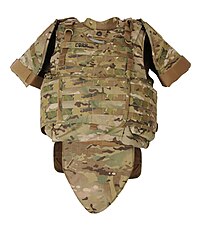
Photo from wikipedia
Abstract Clamped rectangular orthogonal 3D woven carbon composite beams under ballistic impact at a velocity range 60 ms - 1 ⩽ v 0 ⩽ 190 ms - 1 were investigated… Click to show full abstract
Abstract Clamped rectangular orthogonal 3D woven carbon composite beams under ballistic impact at a velocity range 60 ms - 1 ⩽ v 0 ⩽ 190 ms - 1 were investigated in order to understand the damage mechanisms within the material and the role of through-the-thickness (TTT) reinforcement. Experimental tests revealed three distinct categories of beam response: (i) low velocity impacts ( v 0 110 ms - 1 ) which featured projectile rebound, with dominant matrix cracking and localised fibre fracture, (ii) medium velocity impact ( 110 ms - 1 ⩽ v 0 148 ms - 1 ) which exhibited a stretch-deformation dominated failure mechanism, and (iii) higher velocity impacts ( v 0 ⩾ 148 ms - 1 ) which resulted in projectile penetration, combined with longitudinal fibre fracture at the centre of the sample. Finite element (FE) simulations were conducted to understand the experimental outcomes, which showed sufficient fidelity and captured the three distinct beam response regimes. The presence of the TTT-reinforcement can suppress the inter-laminar matrix crack propagation and increase the material ballistic impact resistance for low velocity impact and high velocity impact. However, for medium velocity impact, the in-plane fibre fracture surface was found to be at the locations of TTT-reinforcement. This may suggest that the TTT-reinforcement creates weak points for the stretch-deformation dominated failure mechanism. The verified FE simulations were conducted to predict the multi-hit ballistic impact limit surfaces for the clamped circular 3D woven composite plates, and for the equivalent laminate composite without the presence of the TTT reinforcement. The numerical results suggested the presence of TTT reinforcement could improve the multi-hit ballistic resistance of the composite plates for multi-hit scenarios where the initial impact is 50%–95% of the ballistic limit of the plates.
Journal Title: Composite Structures
Year Published: 2018
Link to full text (if available)
Share on Social Media: Sign Up to like & get
recommendations!